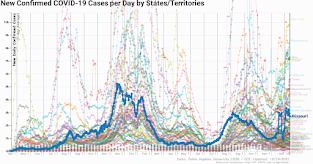What will be the total hospital payouts for all the combined Covid cases?
No Wonder Big Pharma pushed this bioweapon on the people.
I'm rechecking these numbers. If this is how much Hospitals earned from Covid I see why the push used to get everyone inoculated with the bioweapon:
— Scotty (@StLHandyMan) April 3, 2022
[All States] Total Per Covid Patient $2,631,471,568.63
Average [State] per Covid Patient $171,431.37 #BigPharma https://t.co/ZhMbo84bnZ
HHS recently began distributing the first $30 billion of emergency funding designated for hospitals in the Coronavirus Aid, Relief, and Economic Security Act. Some of the states hit hardest by the COVID-19 pandemic will receive less funding than states touched relatively lightly, according to an analysis by Kaiser Health News.
 |
| Missouri $175,000 received by the Government for each covid case reported State-by-state breakdown of federal aid per COVID-19 case |
What sort of care did the victims of the bioweapon receive in West Virginia compared to New York? pic.twitter.com/0u1QBh9thm
— Scotty (@StLHandyMan) April 3, 2022
What sort of Car was provided to the different states?
The first round of grants will be distributed based on historical share Medicare revenue, not based on COVID-19 burden. Therefore, hard-hit states like New York will receive far less per COVID-19 case than most other states.
HHS said it doled out the first slice of funding based on Medicare revenue to get support to hospitals as quickly as possible. The agency said the next round of grants "will focus on providers in areas particularly impacted by the COVID-19 outbreak," rural hospitals and other healthcare providers that receive much of their revenues from Medicaid.
Below is a breakdown of how much funding per COVID-19 case each state will receive from the first $30 billion in aid. Kaiser Health News used a state breakdown provided to the House Ways and Means Committee by HHS along with COVID-19 cases tabulated by The New York Times for its analysis.
Missouri $175,000 received by the Government for each covid case reported State-by-state breakdown of federal aid per COVID-19 case https://t.co/KPaU6ZdScr?
— Scotty (@StLHandyMan) April 3, 2022
per COVID-19 case
Alabama
$158,000
Alaska
$306,000
Arizona
$23,000
Arkansas
$285,000
California
$145,000
Colorado
$58,000
Connecticut
$38,000
Delaware
$127,000
District of Columbia
$56,000
Florida
$132,000
Georgia
$73,000
Hawaii
$301,000
Idaho
$100,000
Illinois
$73,000
Indiana
$105,000
Iowa
$235,000
Kansas
$291,000
Kentucky
$297,000
Louisiana
$26,000
Maine
$260,000
Maryland
$120,000
Massachusetts
$44,000
Michigan
$44,000
Minnesota
$380,000
Mississippi
$166,000
Missouri
$175,000
Montana
$315,000
Nebraska
$379,000
Nevada
$98,000
New Hampshire
$201,000
New Jersey
$18,000
New Mexico
$171,000
New York
$12,000
North Carolina
$252,000
North Dakota
$339,000
Ohio
$180,000
Oklahoma
$291,000
Oregon
$220,000
Pennsylvania
$68,000
Rhode Island
$52,000
South Carolina
$186,000
South Dakota
$241,000
Tennessee
$166,000
Texas
$184,000
Utah
$94,000
Vermont
$87,000
Virginia
$201,000
Washington
$58,000
West Virginia
$471,000
Wisconsin
$163,000
Wyoming
$278,000
What will be the total hospital payouts for all the combined Covid cases? This number is going to be huge. No Wonder Big Pharma pushed this bioweapon on the people. Greedy B'stards.
— Scotty (@StLHandyMan) April 3, 2022











